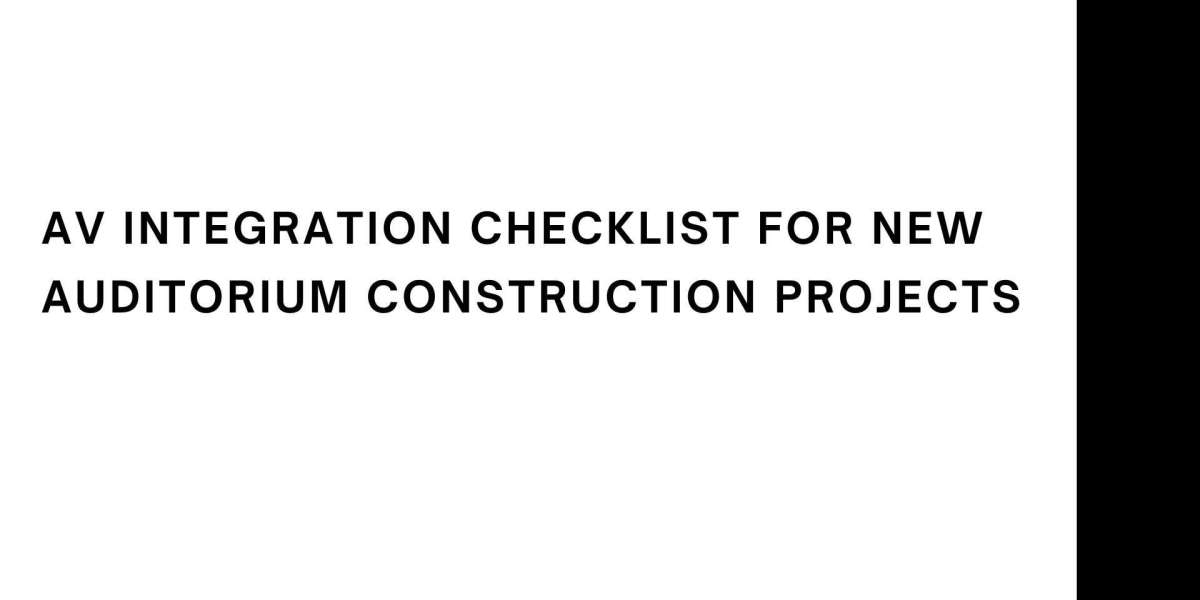Building a new auditorium from the ground up is an exciting opportunity to create a powerful, flexible, and future-ready space. Whether it’s being constructed for a school, university, corporate facility, government center, or house of worship, the auditorium must be equipped with a high-performance AV system that supports presentations, performances, live streaming, hybrid events, and more.
However, integrating AV technology into a new auditorium build is not a simple add-on. It requires careful planning, close coordination with architects and contractors, and a deep understanding of how the space will be used. That is where XTEN-AV becomes an essential tool. XTEN-AV empowers AV integrators to design, document, and execute large-scale AV systems with speed, accuracy, and collaboration. It streamlines every stage of the project, from initial concept to final proposal, and ensures that every piece of technology is accounted for.
In this blog, we provide a comprehensive checklist for auditorium AV integration during new construction projects. Whether you are an AV integrator, consultant, or project manager, these key areas will help you deliver systems that are both high-performing and future-proof.
1. Define the Purpose and Use Cases
Every auditorium serves a unique purpose, and the AV system must be tailored to meet those specific needs.
Questions to ask the client
Will the auditorium host live performances, lectures, or hybrid events?
Will the space be used for recordings or live broadcasts?
What is the expected audience size and seating layout?
Will students or non-technical users operate the system?
By defining the use cases early, you can avoid overdesigning or underestimating the system requirements. XTEN-AV helps by allowing integrators to customize project templates for different types of venues.
2. Collaborate with Architects and Contractors
AV integration should be part of the planning process from day one—not something added in the final stages. Coordinating with architects and construction teams ensures that the infrastructure supports the AV system’s needs.
Key collaboration points
Ceiling height and speaker placement
Lighting layout and projection angles
Electrical and power distribution
Conduit runs for cabling
Rack space and equipment rooms
XTEN-AV supports collaboration through its cloud-based platform, making it easy to share AV designs with other trades and update plans in real time.
3. Plan the Audio System
Audio is one of the most critical aspects of auditorium AV integration. Poor sound quality can ruin even the best event.
Audio system elements to consider
Distributed speaker systems for full-room coverage
Wireless microphones (handheld, lavalier, and gooseneck)
DSPs for mixing and signal management
Assistive listening systems for accessibility compliance
Acoustic treatment recommendations
Using XTEN-AV, integrators can map speaker zones, document cable paths, and ensure all audio components are correctly specified and placed.
4. Design the Visual Experience
Whether the audience is watching a keynote presentation or a stage production, clear visuals are a must.
Visual system requirements may include
High-lumen projectors or LED video walls
Projection screens or surfaces sized to the room
PTZ cameras for recording and streaming
Source switching and video scaling
Stage monitors or confidence displays
XTEN-AV’s product library allows you to compare options from top manufacturers and create visual signal flows that match the space’s layout and lighting conditions.
5. Build a Simple, Centralized Control System
A powerful AV system is only effective if it’s easy to use. Design a control system that simplifies operations for staff, teachers, or technicians.
Control features to include
Touch panels with pre-set modes
Mobile or tablet access for remote management
Scheduling automation for recurring events
Integration with lighting and HVAC controls
With XTEN-AV, integrators can document every control device, cable, and configuration, making it easier to program and troubleshoot later.
6. Address Networking and Infrastructure
A strong AV system relies on a solid foundation of IT infrastructure and network connectivity.
Networking considerations
Dedicated VLANs for AV over IP systems
Gigabit or 10-Gig network switches
Wireless access points for BYOD (Bring Your Own Device) compatibility
Fiber or copper cabling for signal transport
Equipment cooling and power backup
XTEN-AV helps map all network-connected devices and generate cable schedules, ensuring that the infrastructure matches the AV requirements.
7. Document Everything Thoroughly
In a construction project with dozens of vendors, contractors, and deadlines, documentation is critical. It helps installers, electricians, and IT teams understand exactly what to do and where each component belongs.
Essential documentation includes
Rack elevations
Cable schedules
Floor plans with AV device locations
Signal flow diagrams
BOM (Bill of Materials) and part numbers
XTEN-AV automates documentation from your design, helping integrators save time and reduce installation errors.
8. Include Training and Ongoing Support
Once the auditorium is complete, your job is not over. Clients need to know how to use the system and keep it running smoothly.
Post-installation steps
Provide system operation training for all user types
Offer quick-start guides or control interface diagrams
Schedule system maintenance or remote monitoring
Provide documentation for future upgrades or troubleshooting
XTEN-AV’s cloud-based platform allows easy updates to project files, which can be referenced during training or support.
9. Test and Tune Before Opening
Before handing off the system to the client, perform a full system test. Make sure audio is balanced, video sources switch cleanly, and controls function as programmed.
Testing checklist
Line-check all microphones and speakers
Calibrate projectors and display settings
Confirm streaming functionality and camera presets
Test user interface presets and system automation
This step ensures that everything works flawlessly during the first event in the new auditorium.
Conclusion
New auditorium construction offers the perfect opportunity to implement a powerful AV system that enhances communication, performance, and collaboration. But achieving this requires a methodical approach, close coordination with other professionals, and a strong AV design platform.
XTEN-AV makes auditorium AV integration faster, smarter, and more accurate. From speaker layouts and video signal routing to proposals and documentation, XTEN-AV provides a complete toolkit for delivering high-performance AV systems in large venues.
By following this checklist and using the right tools, AV integrators can turn a bare-bones auditorium into a tech-enhanced space ready for any event in 2025 and beyond.
Read more: https://meta.mactan.com.br/read-blog/73057








